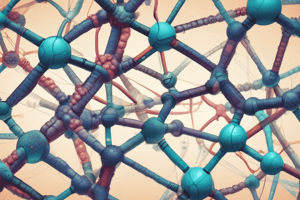Podcast
Questions and Answers
What is the main function of cofactors in enzyme activity?
What is the main function of cofactors in enzyme activity?
- To cleave bonds by adding water
- To activate proenzymes
- To increase the activation energy of a reaction
- To help apoenzymes become holoenzymes (correct)
Where are extracellular enzymes found?
Where are extracellular enzymes found?
- In the gastrointestinal tract, blood, and extracellular matrix (correct)
- In the nucleus of cells
- Only in the extracellular matrix
- In the cytoplasm of cells
What is the function of the active site in an enzyme?
What is the function of the active site in an enzyme?
- To bind the substrate and lower the activation energy (correct)
- To increase the activation energy of a reaction
- To cleave bonds by adding water
- To transfer electrons between molecules
What type of enzymes transfer electrons between molecules?
What type of enzymes transfer electrons between molecules?
What is the purpose of compartmentalizing enzymes into organelles within cells?
What is the purpose of compartmentalizing enzymes into organelles within cells?
What type of enzymes break chemical bonds without hydrolysis or oxidation-reduction?
What type of enzymes break chemical bonds without hydrolysis or oxidation-reduction?
What is the function of acetylcholinesterase, a plasma membrane enzyme?
What is the function of acetylcholinesterase, a plasma membrane enzyme?
What is the shape of the reaction velocity curve with increasing substrate concentration?
What is the shape of the reaction velocity curve with increasing substrate concentration?
Which of the following is NOT a characteristic of enzymes?
Which of the following is NOT a characteristic of enzymes?
Isoenzymes differ from regular enzymes in that they:
Isoenzymes differ from regular enzymes in that they:
Which of the following statements is TRUE about proenzymes?
Which of the following statements is TRUE about proenzymes?
How do cofactors assist enzymes in catalyzing reactions?
How do cofactors assist enzymes in catalyzing reactions?
Why are enzymes compartmentalized within cells?
Why are enzymes compartmentalized within cells?
Which of the following is NOT a function of extracellular enzymes?
Which of the following is NOT a function of extracellular enzymes?
What type of enzyme inhibitors bind to the active site of an enzyme and compete with the substrate for binding?
What type of enzyme inhibitors bind to the active site of an enzyme and compete with the substrate for binding?
Which of the following is NOT a mechanism of enzyme activity regulation?
Which of the following is NOT a mechanism of enzyme activity regulation?
Study Notes
Characteristics of Enzymes
- Enzymes are catalysts that are not consumed in reactions
- They are mainly proteins, highly specific, and interact with substrates
Isoenzymes
- Isoenzymes are different enzymes that catalyze the same reaction but are produced by different tissues
- Example: hexokinase/glucokinase
Proenzymes
- Proenzymes (or zymogens) are inactive enzymes with extra protein sequences
- They are activated by cutting off the extra protein sequence
- Mainly found as extracellular enzymes, e.g. digestive proteases
Cofactors
- Cofactors help apoenzymes become holoenzymes
- Types of cofactors:
- Metal ions that can bind substrates
- Small organic molecules (coenzymes) derived from vitamins
- Cofactors participate in oxidation and reduction reactions
Enzyme Compartmentalization
- Enzymes are found intracellularly, compartmentalized into their organelles
- This separates specific biochemical pathways
Extracellular Enzymes
- Found in:
- Gastrointestinal tract (to digest dietary macromolecules)
- Blood (to mediate blood clot formation)
- Extracellular matrix (for remodeling during normal tissue turnover and tissue injury)
Plasma Membrane Enzymes
- Sit inside the cell membrane
- Examples:
- Acetylcholinesterase degrades extracellular neurotransmitters
- Cyclooxygenases produce inflammatory mediators
Enzyme Catalysis
- The active site allows for catalytic activity due to its cofactors and amino acid side chains that bind the substrate
- Enzymes lower activation energy, and the binding of substrate to enzyme further lowers activation energy to make the reaction easier
Classes of Enzymes
-
- Oxidoreductases: transfer electrons between molecules
-
- Transferases: transfer functional groups
-
- Hydrolases: cleave bonds by adding water
-
- Lyases: break chemical bonds (not by hydrolysis or oxidation-reduction)
-
- Isomerases: rearrange molecule structure
-
- Ligases: form bonds between two large molecules
Enzyme Kinetics
- Reaction velocity shows saturation kinetics with increasing substrate concentration (hyperbolic curve)
Allosteric Enzymes
- Allosteric enzymes differ from regular enzymes in their regulation
Environmental Factors Affecting Enzyme Function
- Various environmental factors affect enzyme function
Michaelis-Menten Kinetics
- Vmax and Km represent the maximum reaction rate and the substrate concentration at which the reaction rate is half of Vmax, respectively
Lineweaver Burk Plot
- Provides information about substrate binding affinity and maximum reaction rate
Enzyme Inhibitors
- Irreversible enzyme inhibitors: covalently bind to enzymes, permanently inactivating them
- Reversible enzyme inhibitors: bind non-covalently to enzymes, reducing their activity
- Examples of competitive inhibitors: succinate and malonate
- Noncompetitive inhibitors affect enzyme kinetics differently than competitive inhibitors
Mechanisms of Enzyme Activity Regulation
- Proenzymes typically activated by cutting off extra protein sequences
- Allosteric effectors influence enzyme activity
- Feedback inhibition regulates enzyme activity
- Phosphorylation and dephosphorylation regulate enzyme activity
Diagnostics
- Creatine Phosphokinase is used in diagnosing heart attacks
- Enzyme levels change during tissue or organ damage
- Different tissues produce different versions of enzymes that catalyze the same reaction
Studying That Suits You
Use AI to generate personalized quizzes and flashcards to suit your learning preferences.
Description
This quiz covers the key characteristics of enzymes, types of enzymes, and their functions in the cell. It also explores how enzymes catalyze reactions, cofactors, and more.



